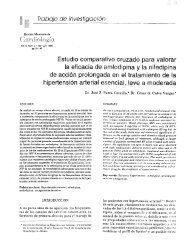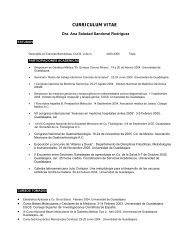Desigualdad Social y Equidad en Salud: Perspectivas Internacionales
Desigualdad Social y Equidad en Salud: Perspectivas Internacionales
Desigualdad Social y Equidad en Salud: Perspectivas Internacionales
- No tags were found...
You also want an ePaper? Increase the reach of your titles
YUMPU automatically turns print PDFs into web optimized ePapers that Google loves.
power at all, and to those with a higher purchasing power but whose health car<strong>en</strong>eeds require a more complex mix of services (Elias and Cohn 2003). In fact, theutilization rates by type of service varied, highlighting the large inequalities in qualityof care delivered across income groups. The highest income group used about500 perc<strong>en</strong>t more private services and about 100 perc<strong>en</strong>t more outpati<strong>en</strong>t servicesthan the lowest income group. On the other hand, people in the lowest incomegroup used 67 perc<strong>en</strong>t more Health C<strong>en</strong>ter Services and 43 perc<strong>en</strong>t more emerg<strong>en</strong>cyservices than the highest income group. There were no social inequalities in the useof inpati<strong>en</strong>t services. (Almeida, Travassos et al. 2000)Studies that are refer<strong>en</strong>ced from other countries like Guatemala, Jamaica, andPeru coincide with the exist<strong>en</strong>ce of inequalities in the services offered to rich andpoor population. (Almeida 2002)In addition to the inequality betwe<strong>en</strong> differ<strong>en</strong>t income groups, the dec<strong>en</strong>tralizationprocess shows contradictory effects in the equity of utilization of services betwe<strong>en</strong> geographicalareas. Some countries seem to have a positive effect on equity. For example,in Colombia, a more equitable utilization of services betwe<strong>en</strong> rural and urban areasand betwe<strong>en</strong> municipalities with differ<strong>en</strong>t income level is noted (Bossert, Larranaga etal. 2003), although there is a higher d<strong>en</strong>sity of health resources in the biggest urbanc<strong>en</strong>tres (Málaga, Latorre et al. 2000). In addition, although geographical inequalitiesare described in Costa Rica, (Vargas, Vazquez et al. 2002), there is evid<strong>en</strong>ce suggestinga positive effect of the reform in reducing the gap betwe<strong>en</strong> rich and poor regions(Rosero-Bixby 2004). Since the differ<strong>en</strong>ces of the processes betwe<strong>en</strong> these two countriesare great, the reasons for these findings require further discussion. For instance,a more equitable distribution of allocation of resources betwe<strong>en</strong> municipalities inColombia as is showed below could play a role in these findings. In Costa Rica, thedec<strong>en</strong>tralization process focused initially in those areas with less access, which seemedto be an adequate policy due to the results in reducing geographical inequity.A positive t<strong>en</strong>d<strong>en</strong>cy an also be noted in Brazil, where the local governm<strong>en</strong>t becamea stronger service provider and interregional differ<strong>en</strong>ces in services supply diminished.The int<strong>en</strong>sity of these changes, however, differed greatly from one regionto another. Despite regulatory measures to increase effici<strong>en</strong>cy and reduce inequalitieswithin the health system, inpati<strong>en</strong>t care delivery in 1996 remained highly unequalacross the geographical regions, with inhabitants of the less developed areas lesslikely to have access to appropriate care. In addition, hinterland cities in the Southeasthave a much better supply of physicians than do the less developed regions.This distribution of physicians, nurses and d<strong>en</strong>tists results in a deficit in the poorerregions and cities and a surplus in the richer ones. (Almeida, Travassos et al. 2000).Reform seems to improve geographic equity although there is still a big differ<strong>en</strong>cebetwe<strong>en</strong> regions. (Viana, Heimann et al. 2002)Unlike Colombia, Costa Rica and Brazil, the effects on geographical equity ofaccess to services in other countries is less promissory. For example, in Chile, the18 Dec<strong>en</strong>tralization And Equity
















